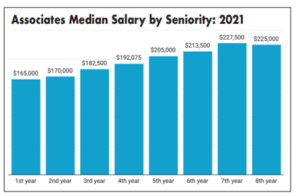If you’ve been tasked with filling lawyer jobs, it’s no secret that hiring a traditional law firm associate is expensive. In fact, the expense can be so intimidating that many solo attorneys and small firms delay hiring just to avoid the cost despite the fact they desperately need help. Salary makes up a large chunk of law firm associate compensation but what other costs are involved?
SALARY
The National Association for Law Placement (NALP) has a quick-reference list of data for first year associate starting salaries for the last 20 years.[1] In their 2021 Associate Salary Survey, NALP report that “the overall median first-year base salary as of January 1, 2021 was $165,000, up $10,000 (6.5%) from 2019.” That gives some sort of starting point for compensation metrics, but that’s just the start.
So knowing what your specific geographical market looks like — and whether you’re a big law firm in New York or a small one in the Midwest — will also factor into how to calculate compensation for a law firm associate. Starting salaries for entry-level lawyers can vary greatly in each jurisdiction.
Starting salaries for lawyer jobs can also vary based on your practice area. Firms that specialize in areas such as intellectual property or commercial litigation may pay different starting salaries than personal injury or family law firms.
Experience is another factor that needs to go into how much you should expect to pay a full-time legal associate, if they’re not straight out of law school. The ABA Profile of the Legal Profession (2021)[2] cites that same NALP study when breaking down salary trends by years of experience. While the median salary for a first-year associate is $165,000, the median for an eighth-year associate is $225,000.

Source: ABA Profile of the Legal Profession (2021)
The same ABA report details that over the 20-year span from 2000 to 2020, lawyer salaries increased faster than the rate of inflation. Lawyer salaries rose 63% while the inflation rate was 53%.
However, despite the on-going rise in associate salaries law firms are still plagued with turnover. In early 2022, the ABA Journal reported that associate compensation increased 11.3% through November 2021 on a rolling 12-month basis and during the same time period – despite the rise in salaries – associate turnover rate for law firms reached 23.2%.[3]
The on-going war for talent is creating a vicious cycle of salary increases and turnover that is simply not sustainable for a successful, modern law firm business model.
TRAINING IN THE LEGAL FIELD
If you’re looking to hire a new lawyer who is fresh out of law school, you’ll also need to factor in training time and costs. And by “time,” that may mean your time, specifically. Teaching a young attorney all the practical industry knowledge, best practices, firm standards, and tricks of the trade they need to know to perform well is in your best interest, but it’s time consuming.
Mentoring a law student or summer associate who you bring on as an associate attorney is a serious time commitment. You need to commit to dedicating time every week, perhaps even every single day, to supervise their work as well as give practice and legal advice.
This can turn into a huge expense that many attorneys easily become frustrated with — because while you may feel like you’re investing in a long-term hire, it’s possible that you could spend a lot of resources training an employee who ends up leaving you to go work for a competitor. Then you have hundreds of hours of your own billable time down the drain.
Conversely, if you hire a more senior associate, they may bring bad habits or simply different work standards with them. Even if you don’t have to teach experienced attorneys the ground-level basics, you’ll still need to help them unlearn those bad habits and/or adjust to your firm’s way of functioning. And if that isn’t an easy transition, you may find yourself picking up the slack during the training period.
BENEFITS
Besides salaries, benefits can add up quickly in the legal industry. According to the U.S. Bureau of Labor Statistics, as of December 2021[4], almost a third of employee costs to employers were benefits. While the average per hour cost of an employee was $39.55, benefits accounted for $12.20 of that cost. This means that whatever the employee’s salary is, you could need to add another 30% or more to cover the cost of their benefits.
Then there’s retirement, which is typically 2% to 6%[5] in matching contributions from an employer. If you have a first-year new hire at the median salary rate of $165,000, that’s another $3,300 to $9,900 per year for retirement for that associate.
Health insurance is another large expense of hiring a traditional associate. According to the 2021 Milliman Medical Index[6], the cost of healthcare for a typical American family of four covered by an average employer-sponsored preferred provider organization (PPO) plan is $28,256. The Kaiser Family Foundation reports that in 2021 employers paid 73% of the annual premium to cover a family of four.[7]
The benefits list is seemingly endless. Other benefit to consider when calculating the cost of hiring an associate include dental insurance ($1,500 to $4,500), disability insurance ($2,000 to $5,000), life insurance ($250 to $500), employer contributions to FICA (7.65% of salary, which at $165,000 would be another $12,623). None of this includes other possibly benefits such as unemployment insurance, tuition reimbursement, student loan benefits, financial wellness benefits, and any other voluntary benefits which might be standard for your law firm to provide to associates (think commuter benefits, gym memberships, etc.).[8]
MALPRACTICE INSURANCE
An associate is also going to need to be covered by malpractice insurance for the legal work they provide. Rates are typically around $2,500 to $3,500 per year according to ALPS[9], but can certain be much higher. The annual rate for a policy can fluctuate depending upon practice area, experience level and state or location risk factors.
Be certain to discuss your firm’s insurance needs with your carrier as your staffing grows and changes. Find out if law student clerks, summer associates and/or paralegals are covered by your malpractice insurance.
BAR DUES & CLE
The employing law firm also typically pays for an associate’s annual bar dues and continuing legal education requirements. These costs can vary from state to state, as the number of hours required vary across the country. In our experience, this can account for at least $1,000 per year per associate.
In addition there can be local bars or specialty bars that a new associate attorney may benefit from joining. Networking has been a huge challenge for new lawyers during the pandemic. However, now that many groups are resuming in-person meetings there can be immense personal and professional benefits to the law firm fronting the cost of these memberships.
OFFICE & EQUIPMENT
Now more than ever, associates are going to need access to an entire suite of office equipment. And while multiple employees used to be able to share larger equipment such as in-office printers, any work-from-home employee will now also need access to their own version of the equipment at home.
Hardware may include laptops, scanners, printers, paper goods and office supplies, office furniture, and a cell phone (with service coverage). These costs will easily range in the thousands of dollars.
Software may include access to your practice management software as well as any research accounts they need access to. Litigation attorneys may need e-discovery tools. Transactional practice groups may need deal management software for their legal matters. Estate planning firms may need specialized drafting software for legal documents. These necessities can easily add up to around $2,500 per year per associate or more and are paid for by the law firm.
Whether you’re primarily a virtual law firm or hybrid, most attorneys will at some point need actual office space – real estate – at which to meet with clients or conduct depositions in person. Office space will need to be provided in some capacity for those aspects of legal work best done in person.
THE COST OF UNDER-UTILIZATION
It’s natural that the workflow of a law firm ebbs and flows. Sometimes you’re drowning in work. Sometimes you’re waiting for the next new client to call.
These peaks and valleys in workflow also hold many law firms back from making a full time hire. No one wants the stress of having to make payroll to a new lawyer who isn’t producing billables when the cashflow has dried up.
The 2020 Altman Weil Law Firms in Transition report found that 84.4% of surveyed law firms reported having chronically under-performing lawyers. Further, the report found that in nearly a quarter of all law firms, more than 10% of lawyers were considered to be under-performers.[10]
Why Freelance Lawyers (aka Virtual Associates) Make Sense (and Cents)
Working with a Virtual Associate allows you to get access to the help you need, when you need it. A part-time Virtual Associate can be a much better staffing solution than a full-time associate for a lot of reasons.
First, freelance attorneys don’t have overhead costs tied to them. There are no benefits, insurance, equipment, or salaries to commit to when hiring a freelancer, and the freelancer will only work when you need them to.
So if you don’t have as much work in any given month, you’ll have no overhead as you would an employee. No salary, health insurance, retirement, or other benefit costs.
Another benefit is that working with a Virtual Associate often allows you to connect with a seasoned lawyer who can do the legal work without training or hand holding. You – and your client – can benefit from the Virtual Associate’s years of experience.
Last, you don’t have to worry about the natural fluctuations in your work volume. If you aren’t busy, don’t send any work to the Virtual Associate. If you are slammed, you can connect with multiple Virtual Associates to get the immediate help you need.
At LAWCLERK we strive to provide technology and tools that empower attorneys to build their ideal practices, be more profitable, find fulfillment and well-being.
[1] https://www.nalp.org/privatesectorsalaries
[2] https://www.americanbar.org/content/dam/aba/administrative/news/2021/0721/polp.pdf
[3] https://www.abajournal.com/news/article/law-firms-came-dangerously-close-to-losing-a-quarter-of-their-associates-in-2021
[4] https://www.bls.gov/news.release/ecec.nr0.htm
[5] https://www.forbes.com/sites/financialfinesse/2018/09/24/how-much-are-your-benefits-really-worth/?sh=17f1bf617879
[6] https://www.milliman.com/en/insight/2021-Milliman-Medical-Index
[7] https://www.peoplekeep.com/blog/cost-of-employer-sponsored-health-insurance
[8] https://www.forbes.com/sites/financialfinesse/2018/09/24/how-much-are-your-benefits-really-worth/?sh=17f1bf617879
[9] https://www.alpsinsurance.com/about/true-cost-of-legal-malpractice-insurance



















